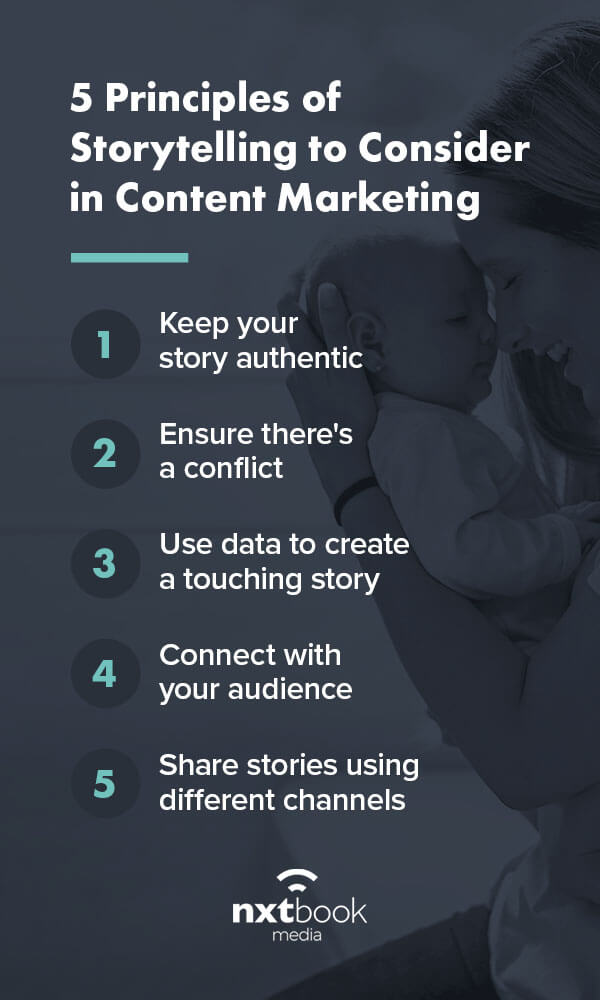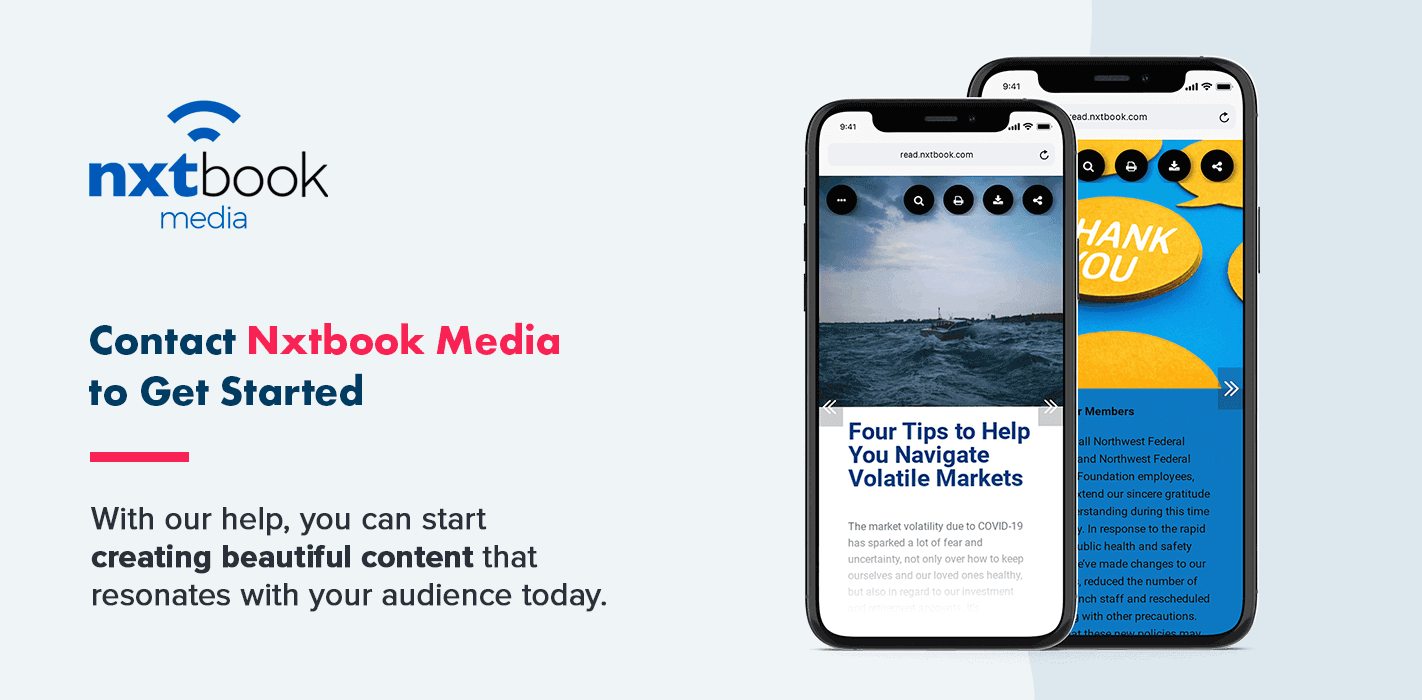The Power of Storytelling Within Content Marketing

Written by Matt Berringer
January 3, 2022

Have you ever been listening to a lecture, a TED Talk or a presentation and noticed that the speaker always uses real-life experiences and stories to convey the message to you? There’s a reason why — people love listening to stories, as they can make certain topics relatable. When it comes to content marketing, you want to ensure your audience resonates with your product or service, and storytelling helps you accomplish that.
Here’s a look at a few ways storytelling matters, business storytelling examples and how you can use stories to connect with your consumers.
What Is Storytelling in Content Marketing?
In short, storytelling in marketing involves sharing a story that portrays points and challenges that ties back to what you’re offering. Since content marketing involves the creation and distribution of relevant content to reach a particular group of people, storytelling is essentially a tool that helps you better reach your target demographic. Think of it as a party trick that can truly draw in your intended customer base.
When you’re trying to reach a certain audience, you want to be able to connect with them. If you can connect with the audience, they’ll understand why what you’re selling pertains to them, and they’ll be more inclined to give it a try. Every day, brands try to target people through content marketing — and a genuine, compelling story can help you stand apart.
The Science of How Storytelling Works
Believe it or not, storytelling is backed by science. Consider the last time you watched a truly great movie. There was a beginning, middle and end that managed to continuously capture your attention, evoking various emotions — but why did you feel so engaged? After all, a movie is really only a bunch of actors reading from a script, and yet millions of people enjoy watching movies every day.
At a basic level, humans require and seek emotional connections in life. When you watch a sad scene in a movie, you begin to feel empathic toward the character experiencing the hardship. The brain’s oxytocin hormone becomes activated, causing us to start feeling various emotions, including compassion. One study shows that a well-told story makes us feel as though we’re experiencing the story ourselves, which explains why you may feel immersed when watching a movie.
If you examine storytelling a little more closely, you might note that it connects to memory. There’s a reason behind why we have favorite movies, and can remember specific scenes or even lines from them months and years after watching. A strong narrative becomes engrained in the brain, as cortisol helps the brain store memories that align with patterns — and almost all stories involve an introduction, conflict, resolution and ending.
Overall, people love experiencing stories because they make us human. Rather than telling a person to try your product or service “just because,” you must know how to engage with them through a proper content marketing strategy — and storytelling can be an integral part of your plan. Employing digital marketing through storytelling will help you become a brand your customers truly enjoy.
Storytelling as a Content Marketing Strategy
When it comes to content marketing, using a story can help your target audience connect with your message based on emotion. If you manage to create a story that hits the emotional nail on the head, your audience will likely make a purchase — the American Society for the Prevention of Cruelty to Animals (ASPCA) raised $30 million from its famous “Angel” ad in the year following its release, and continues to run it over 10 years later. A well-told emotional story leads to success.

Relying on the Monomyth, or the Hero’s Journey, as you create stories for your content will ensure your products and services stay in your customers’ minds after they engage with your marketing. When combined with just the right amount of emotion, a story that follows a familiar pattern will be easy to remember. If your target consumer doesn’t make a purchase immediately, they’ll certainly tell their friends about your ad — and likely come back later to buy.
What to Keep in Mind When Using Brand Storytelling
But you have to be careful with your storytelling. While you can tell a story to get your audience laughing or crying, you must ensure that it fully relates to what you’re selling. When trying to find the perfect story for your marketing, you’ll want to think about how your product or service benefits consumers. What problem will it help them solve? What benefits does it offer to them? What makes your products or services better than your competitors?
Any story you create should help answer the above questions for your audience. Using a choppy, vague story that doesn’t fully outline what you’re selling will only be confusing. Be sure that your story connects to your brand, as well. A piece of content marketing directly reflects your company, so it should align with your goals and values — starkly differentiating from your usual content can be an unwelcome surprise.
Successfully using storytelling in your content marketing can do more than create a customer connection and push your brand’s mission. Doing so will also help you expand your audience, converting customers to loyal patrons along the way. There are so many types of content marketing that exist — blogs, infographics, newsletters, videos and more. By enhancing your content with stories, you can resonate with more customers in a sea of content marketing, convincing them you’re the best option.
5 Principles of Storytelling to Consider in Content Marketing
As stated above, nearly every story you hear has a beginning, problem, solution and ending, otherwise known as the Hero’s Journey. Because you aren’t creating a 300-page book or a 90-minute film, you don’t have to dive too deeply into the model’s structure. However, you should note a few storytelling principles to help make your content as impactful as possible:

1. Keep Your Story Authentic
When it comes to marketing, people really like authenticity. Never pretend to be someone you’re not or take too much inspiration from people’s ideas and stories. Share a story that’s genuine and unique, so you can stay true to your brand. If you’re innovative and creative, your target consumers will see that and respond positively. Truly inspiring content that pushes people to act is always unique and real.
2. Ensure There’s a Conflict
Every great story features some kind of conflict. This conflict doesn’t have to be anything intense or dramatic, but you should include a situation that the hero of the story has to overcome. A solid conflict evokes emotion — you almost always want the hero to defeat the villain.
However, you have to be careful with your conflict because you can’t give away too much information. To effectively create conflict in your stories, you’ll want to keep three points in mind:
- The hero: The customers should be the protagonist or “hero” of the story. The story should be centered around an issue in their lives.
- The problem: When you begin the story, the protagonist should’ve already failed their current attempt to solve their problem. There should be obstacles that stand in the way of the main character being able to achieve their goal. If they immediately succeed, the story won’t be very interesting.
- The solution: Lastly, your product or service should be what helps the character overcome their problems — just remember that everything shouldn’t fall into place and be solved until the very end of the story.
3. Use Data to Create a Touching Story
When using some sort of story to help sell your product or service, you should also be including data. After all, your content marketing must be successful, creating higher returns and increased engagement. Use visual props to demonstrate data from studies throughout your content marketing. When a story is both compelling and factual, you create more chances to truly reach your audience.
For example, some studies show that hugs help stabilize babies’ vital signs, promote brain development and ward off illnesses. The baby product company Huggies used similar information to create ads that depicted parents hugging their babies, calling the campaign “No Baby Unhugged.” This campaign used real, tangible data to tell an important story — and subtly encourage customers to choose them over their competitors.
4. Connect With Your Audience
If you’re able to truly connect with your audience, it can make all the difference. Generally, consumers don’t want to buy products from a pushy salesperson that doesn’t truly seem to believe their product or service works. Instead, they want someone who shows an interest in what they’re selling and employs quick, verifiable facts to do so.
Additionally, people are much more willing to hear you out when you can build a rapport with them. Through the use of a story, you’re halfway there, as you’re putting forth the effort to get their attention. The best stories will include elements that people feel resonate with them and encourage consumers to continue building a relationship with your brand.
5. Share Stories Using Different Channels
There are many channels you can use to share your stories and products or services. If you create a story for a certain campaign, you must find ways to adapt it with the same results across numerous channels. This way, you can reach as many people as possible, and you don’t have to waste resources creating specific campaigns for each channel.
Through various reports, you likely already know which marketing channels perform best for your brand. These avenues may include social media, videos and podcasts. The power of storytelling is that it can change to fit different modes — a short video ad may be perfect for your Twitter account, and a more in-depth discussion about a related topic will work best for a podcast.
No matter which platforms you decide work well for your brand, you should ensure that your content marketing strategy covers an array of channels. This way, you can use brand storytelling to connect with all kinds of customers. Some will prefer certain marketing channels, so you can cover your bases by utilizing several marketing avenues.
How Can Nxtbook Media Help You Tell Your Story?
Nxtbook Media came to be in the 2000s after years of delivering reprinted magazine articles across the country. Over time, we’ve evolved to creating comprehensive digital platforms that help content creators craft engaging digital content experiences.
At Nxtbook Media, we help content creators thrive. The average platform visitor stays engaged with the content for more than 7 minutes per visit.
The PageRaft platform helps you create stunning digital magazines that capture your brand. This platform comes with numerous features, including options for customization, so you can ensure your readers know you’re creating the content. Additionally, unlike PDFs, your content will seamlessly adjust to fit your readers’ device, eliminating the need for zooming in and out.
The nxtbook platform can turn your current print publication into a modern digital adaptation. With options to create travel guides, brochures, stakeholder reports, and more, you can take existing content and turn it into a visually appealing, easy-to-use online edition. Feel free to spice up your content with was to add slideshows, embed podcast episodes and more.
If you’re considering putting out marketing messages using storytelling, our platforms are an impactful place to start. Through our platforms, you can create various types of content marketing to engage with your audience. Let us help you tell your story!
Contact Nxtbook Media to Get Started
Now that you know the importance of storytelling in content marketing, you may be curious about how to get started. If you’re interested in our programs or want to consult with one of our professionals, contact us on our website or call (866) 268-1219 using option four. With our help, you can start creating beautiful content that resonates with your audience today.
